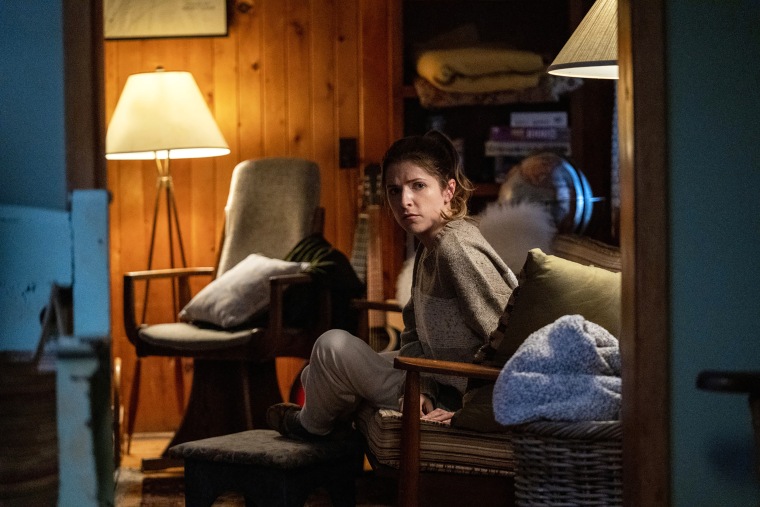“Alice, Darling” has been billed as a thriller, and indeed the trailer’s building dread could easily lead you to think that it’s a slasher in the mode of 2022’s cannibalistic “Fresh” or 2020’s “Invisible Man.” That head fake is intentional. Director Mary Nighy and writer Alanna Francis use the beats of stalker suspense to quietly critique the genre’s narrow vision of interpersonal violence and its default of unitary, personal triumph over adversity. As in “Women Talking,” the creators of “Alice, Darling” step away from pulp tropes in order to step away from patriarchal violence — and patriarchal control.
The creators of “Alice, Darling” step away from pulp tropes in order to step away from patriarchal violence — and patriarchal control.
The Alice of the title is played by Anna Kendrick, who spends the first 15 minutes of the movie broadcasting, through nervous facial expression and terrifyingly rigid body language, that her supposedly idyllic relationship with up-and-coming artist Simon (Charlie Carrick) isn’t nearly as perfect as it looks. When her best friends Sophie (Wunmi Mosaku) and Tess (Kaniehtiio Horn) invite her to a cabin for a week’s vacation, Alice lies to Simon, telling him she’s on a business trip, and ambivalently joins them.
There are numerous hints of upcoming violence. A jump scare early in the movie as Simon joins Alice unexpectedly in the shower is (an almost surely intentional) nod to “Psycho.” The remote location of Sophie’s house, complete with a deep, dark lake, is a staple of slasher films. A girl in the town has disappeared under mysterious circumstances — more potential narrative foreshadowing. Finally, Sophie shows Alice how to use a maul to chop wood. As per slashers, in which the Final Girl is always better at fighting than you’d expect, Alice is unexpectedly enthusiastic about, and skilled with, the tool.
If we were in a horror film, you’d know the story from here. Someone — either Simon or someone like Simon — would come after Sophie, Tess, and Alice one by one. There would be bloody deaths and disembowelments. Alice’s affinity for sharp tools would become her salvation. At the end of the film she, the Final Girl, would reveal her inner strength and a capacity for mega-violence, overcoming the antagonist in an apocalypse of self-actualization.
That’s not what happens here, though. The movie mostly eschews hyperbolic terror and triumph, allowing more intimate moments of anxiety and despair to resonate with nauseating force. Alice is constantly on the verge of coming apart. Every text from Simon sends her into a paroxysm of jitters and anxiety; she sends him sexy cleavage pictures with grim determination. When she loses the earrings he gave her in the lake, she starts diving desperately to find them. It’s like she’s trying to drown herself, or like she’s already drowning.
The persistent anticlimax is intentional. Alice tells her friends at one point that Simon has never hurt her, by which she means that he has not hit her. They are incredulous. It’s obvious that, even if he’s never touched her, Simon has hurt her badly. Genre stalker movies always show us abuse drenched in blood. Real life domestic violence, though, can be less dramatic. Simon is an expert with the weapons of criticism, shame, anger, insults and surveillance. Even the sex scenes are studiously non-violent — though they showcase Alice’s misery quite clearly.
Simon doesn’t need a gun. But neither does Alice need that maul for empowerment.
Simon doesn’t need a gun. But neither does Alice need that maul for empowerment. To ramp up tension and a sense of isolation, thrillers generally focus only on one heroine, who has her support structure systematically stripped from her the better to reveal her lonely awesomeness. But in “Alice, Darling” Sophie and Tess are a resource rather than cannon fodder. The movie is as much about them figuring out what is wrong with their friend as it is about Alice trying to escape from Simon. Again, as in “Women Talking,” the answer to patriarchy isn’t one strong woman smashing the system, but an alternate female community. In this movie, feminism is a collective project.
Collective projects require negotiation and don’t necessarily fit into the tropes of pulp entertainment as seamlessly as straightforward empowerment fantasies. Much of “Alice, Darling” is made up of small, telling moments — Alice refusing to sing along as Sophie plays guitar, Tess putting her hand on Sophie’s heart. In the big confrontation of the film, the three women mostly just stand there, saying almost nothing.
By nodding to stalker/slasher films while refusing to be a stalker/slasher film, “Alice, Darling” may irritate or confuse some viewers. Sometimes, though, it’s important to tell stories even when, or especially when, they aren’t the stories we’re expecting. Alice finds her own way, in part by discovering she doesn’t have to go it alone.
